I like to build stuff that is useful and solves problems. This blog contains things that I find interesting enough to write about.
Friday, October 30, 2009
Non Latin Characters for Domains
Wednesday, October 07, 2009
Google flirting with Code 128 barcodes ?
The Google search page is showing a 1 D barcode (Code 128 font) on the search page instead of the logo. Wonder whats the reasoning behind it... I wouldn't have been surprised to see a 2 dimensional QR code to allow a user to repeat the same search on their mobile phone but the use of a 1D font is intriguing to say the least. I wonder what could be the data encoded in the barcode.... from the looks of it .. shouldn't be more than 8-12 chars given the high density of the code 128 font.
Friday, September 11, 2009
Rules for URL shortening services
 URL shortening has become a vital tool for social media networks especially with Twitter and other micro blogs gaining popularity. A huge number of shortening services have sprung up to meet the needs with some offering additional features like reporting on top of the basic service.
URL shortening has become a vital tool for social media networks especially with Twitter and other micro blogs gaining popularity. A huge number of shortening services have sprung up to meet the needs with some offering additional features like reporting on top of the basic service. - Thou shalt not FRAME my url.
- Thou shalt not display any advertisements during the redirection of my URL.
- Thou shalt not promote additional information during the redirection of my URL.
Thursday, September 10, 2009
An App Store for Enterprise Applications
Monday, August 24, 2009
CNE 2009 Contest uses ScanLife Lotto Codes
To enter, visit the Rogers booth at the CNE during the Contest Period and identify yourself with a Rogers representative to receive instructions how to participate in the Contest. Using the demo BlackBerry® Javelin™ 8900 enabled with the Scanlife software, take a picture of the code as instructed and an instant message will appear on the device confirming if you are potential instant winners ("Entry"). Limit of one (1) Entry per person during the Contest Period.
More details on the contest : http://fivemobile.com/cnecontest/rules.htmlThis is an innovative use of 2D codes in events. I see 2D codes used a lot more in promotions in the events.
Tuesday, August 18, 2009
Startuply: Startup Jobs
Monday, June 22, 2009
Speed Stick Promotion using 2D codes
 Came across the Speed Stick promotion at Penn Station NYC last week. Pretty cool to see 2D codes being used in marketing promotions.
Came across the Speed Stick promotion at Penn Station NYC last week. Pretty cool to see 2D codes being used in marketing promotions. Friday, April 03, 2009
Petition for PHP support on Google App Engine
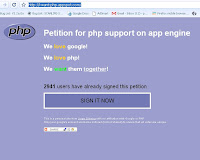
Thursday, April 02, 2009
EZcode® Specifications Publicly Available to be a Global Standard
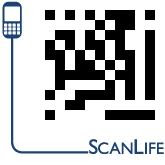
Use QR Codes to talk back with the Author
Wednesday, April 01, 2009
National Post in Canada uses ScanLife
 The National Post, a daily Canadian newspaper, will start using ScanLife EZCodes starting today linking to editorial content from their mobile site (m.nationalpost.com).
The National Post, a daily Canadian newspaper, will start using ScanLife EZCodes starting today linking to editorial content from their mobile site (m.nationalpost.com).Thursday, March 26, 2009
Continous Mode 2d barcode reader for Iphone
 The QuickMark reader (v 3.8) was release early in march. Among support for the other major platforms, this version has a build for the Iphone (availabe on App Store).
The QuickMark reader (v 3.8) was release early in march. Among support for the other major platforms, this version has a build for the Iphone (availabe on App Store). Monday, March 23, 2009
Outsourcing in Sports
Friday, March 20, 2009
2D Barcodes to assist mobile content download


The V-Code (video 2D code) is another technology that could completely revamp the content download space. The only drawback is that since its a video code, it cannot be used on printed material but delivering content from websites would be a breeze especially in markets like India where data service on mobile phones is just picking up and there is a big demand for graphic content.
Thursday, March 19, 2009
Mippin Mobilizer for your Blog
Tuesday, March 17, 2009
Cool use of QR codes and Google Chart API
Monday, March 16, 2009
Menu Collector uses BeeTagg to attract Mobile Customers
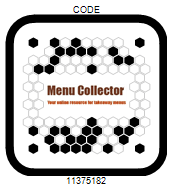 Menu Collector is UK based website that provides users with take away menu's of resturants. The website is currently being developed and at present has only the small area South Wales covered with a limited amount of menu's.
Menu Collector is UK based website that provides users with take away menu's of resturants. The website is currently being developed and at present has only the small area South Wales covered with a limited amount of menu's. QR Code Art
Saturday, March 14, 2009
ScanLife: Multiple Action Codes aka Menu Codes
 Checked out the Menu Codes on ScanLife yet?
Checked out the Menu Codes on ScanLife yet?
 ) from the create code section on the left. If you do not already have a account, you can register for a personal ( free) or Commercial account.
) from the create code section on the left. If you do not already have a account, you can register for a personal ( free) or Commercial account. Friday, March 13, 2009
JAGTAG, "Request 2 Get" flows with barcodes
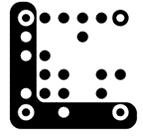 JAGTAG is a proprietery 2D barcode symbology that offers pretty much the same functionality as the other 2D symbologies. The main selling point emphasized here is that you do not need a scanner ( or reader) application installed on your phone. The system works through the MMS ( email for Iphone) model where the end user simply has to snap a picture and MMS it to 524824. Iphone users can email their code image to iphone@jagtag.net. This is similar to the model used by Mobot and some other companies.
JAGTAG is a proprietery 2D barcode symbology that offers pretty much the same functionality as the other 2D symbologies. The main selling point emphasized here is that you do not need a scanner ( or reader) application installed on your phone. The system works through the MMS ( email for Iphone) model where the end user simply has to snap a picture and MMS it to 524824. Iphone users can email their code image to iphone@jagtag.net. This is similar to the model used by Mobot and some other companies.
- Latency issues, MMS and the subsequesnt SMS back can run into latency issues. I bet the actual time that the JAGTAG server takes to decode the image and act on it is in milliseconds but the time taken to send an MMS can lead to a bad user experience
- Success Ratio: The end user needs some training in how to take the image so that the complete barcode is in the picture and size of the barcode modules ( black dots) is large enough for the server algorithm to decipher.
ScanLife EZCodes in Brazil

Thursday, March 12, 2009
UpcodeWorld : Virtual Competition

Web as a mobile Enterprise Application Pllatform
Device Features - One of the main reason that we people use mobile devices is for all of the cool features such as barcode scanning, magnetic stripe readers, cameras, video, messaging, etc. Not to mention a pretty powerful CPU, persistent storage, and the other features of a portable computer. With web apps, you are generally limited to the functionality of your browser. To some extent you can get around this with ActiveX controls and third party browser extensions such as Motorola’s PocketBrowser, but this is all custom.
Bells and Whistles -Audio is a critical component of Enterprise applications. For some reason Microsoft all but eliminated sound from the mobile web. Without audio cues, alerting users of errors is less effective. Again we can use third party tools for this such as PocketBrowser, but…
Web Standards Support - Here’s another big frustration area that drives developers crazy. It’s only natural that the Microsoft developers made some trade offs when they implemented the mobile browsers, but clearly they weren’t targeting it as an application platform from their choices. Take the single window limitation, i.e. no popup window for displaying error messages or alerts. Or not supporting absolute position. While these types of limits don’t prevent development, it just makes things more difficult."
I couldnt agree with him more on the frustration at the lack of support for Web standards. In the mobile world anything goes including very loose implementation and own interpretation of the standards. Device features is another strong point in the demise of WAP. The WTAI spec seems to have been abandoned, I would have hoped that more URI schemes would be added to support access to camera etc but the mobile browser for now is just not heading in that direction.
Another approach would be a thin client application that embeds the browser inside it. This still gives you flexibility to modify the interface from the server and the thin client can access the device features. On BREW, IHTMLVIEWER control is something I have used, pretty flexible though it works only with the HTML 4.1 standard out of the box but certain features can be modifed. On most smart phones including Iphone the browser can be embedded inside the app. This gives flexibility to the server component to adapt and modify the user experience with ease.
Original Post: http://www.steponesystems.com/blog/?p=247
Wednesday, March 11, 2009
Blackberry Browser and the CSS setting for WAP pages
I had been struggling with trying to find some HTTP header or something similar that will allow me to detect on the server whether the blackberry browser has the CSS option turned on or not. As expected, did not find any.
- Come up with text that tells the user that the page is best viewed with CSS turned on. (Possibly add a link to a page that tells the user how exactly to do this).
- Setting the style of the information text above using 2 properties : visibility and display.
Tuesday, March 10, 2009
How to Embed almost anything on your HTML page
SplashURL uses QR codes (SplashQRCode Bookmarklet)
Sunday, March 08, 2009
Inquisitor now on Iphone
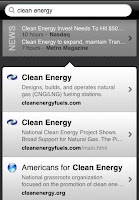
Yahoo Search released the Inquisitor application for Iphone on March 5th. The app speeds up searches like no other through a nifty auto complete and suggestions feature.
"Inquisitor Mobile Search auto-completes your search and gives suggestions as you type to refine your search. When you type in your query, websites and suggestions appear immediately below the search box. Inquisitor also speeds up your search by quickly loading site summaries and allowing you to navigate between results and the browser with just one click."
Friday, March 06, 2009
12Pixels, Draw on your mobile phone, 1 pixel at a time.
12pixels was recently released in Japan in association with Sony Style. The images drawn by the end users can be saved on the phone as wallpapers, converted to emoticons and even sent to friends in messages.
I loved the simplicity of the user interface to make the images, even though the system is not flexible enough to make the monalisa but sure makes it simple to make emoticons. Cool toy to have !!! Some of the works of art are below, you can find more here and here. A blog post by the creator describing the project is here.
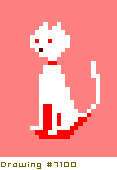
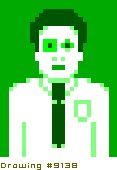
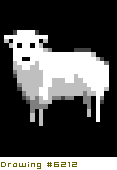
Thursday, March 05, 2009
A list of barcode readers
Check it out: Current graphical tag readers for mobile phones
Cardstar : Scan 1 D codes from your phone and save
The CardStar iPhone application allows users to store their rewards and membership cards on their IPhone from where most merchants can scan them directly from the IPhone screen using the regular laser scanners.This is neat ! think about the clutter it will remove from people's key chains. My key chain currently has (apart from keys) the little barcoded tags of Pathmark, Shoprite, Stop n Shop, NYSC....(the list goes longer each time I visit a new store).
Whats taken such a app to come out for so long?
Previously, 1D barcodes, which are used at most stores, could not be scanned directly from the LCD screen by Laser scanners (used in almost all retail stores at point of sale). Working with the Symbol CS 1504 scanners in my early years taught me this lesson the very painful way.
Tuesday, March 03, 2009
QR codes used to Tag monuments in Dutch city of Utrecht
 The Utrecht Monuments Fund is celebrating 65 years. The foundation is responsible maintainence of historical buildings in the city of Utrecht. The foundation, working in partnership with One Shoe has placed QR codes on the buildings to allow people to get more information on the buildings.
The Utrecht Monuments Fund is celebrating 65 years. The foundation is responsible maintainence of historical buildings in the city of Utrecht. The foundation, working in partnership with One Shoe has placed QR codes on the buildings to allow people to get more information on the buildings. Thursday, February 26, 2009
Website Magazine uses Scanlife 2D Barcodes
Wednesday, February 25, 2009
Perform VooDoo on your phone

- Use the accelerometer to shake and scramble Voodude
- Ragdoll physics ( I wonder what this is)
- Touch screen interactivity puts Voodude at the mercy of your fingers
- Email your creations to other Voodude users (Share the Voodoo spells within the office perhaps)
Tuesday, February 24, 2009
Telecom Italia launches "Flash Me"
 From Scanbuy Press Release: Telecom Italia launches the service ‘Flash Me’, a mobile application based on 2D code technology that utilizes the mobile phone’s camera to read a sort of ‘virtual stamp’ printed on magazines, newspapers and other advertising devices, to directly connect the user to the mobile Internet.
From Scanbuy Press Release: Telecom Italia launches the service ‘Flash Me’, a mobile application based on 2D code technology that utilizes the mobile phone’s camera to read a sort of ‘virtual stamp’ printed on magazines, newspapers and other advertising devices, to directly connect the user to the mobile Internet. Friday, February 20, 2009
Shabbir on the Blogosphere
Monday, February 09, 2009
Mobile Discovery to use ScanLife
Mobile Discovery has previously used ScanLife codes at Case Western University in one of the country’s first large scale trials of the technology. In that project EZcodes were used in a number of ways including the delivery of real-time bus schedules and on print ads from advertisers like QVC.
This is cool.....
Monday, January 26, 2009
QR code on Youtube's Iphone WAP site
This is the question I have been trying to answer in my head but haven't come up with a convincing answer yet.
YouTube has added a link "Qr Code" on the video wap pages just below the Share Video link. The link opens up to a Image of a QR code that is encoded with the URL of the video. What is strange is that this link only appears when I visit wap site with my Iphone. The blackberry and Nokia N70 does not show this link.
So whats the point of allowing a Iphone user to view a QR code image ????
hmmm.... The YouTube app on the Iphone does not scan QR codes... atleast not yet...
One thought that I could come up with was that a newer version of the Iphone YouTube Iphone app would be able to scan the images directory on the phone, locate QR codes, decode them and allow the user to view these videos inside the application. The user visiting the wap site would simply have to save the QR code image in their phone's images directory....

